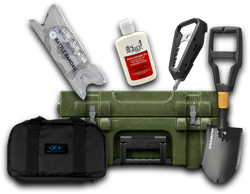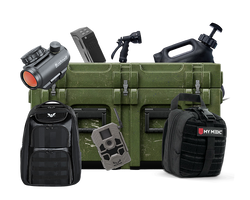
Surviving in the Rainforest
The rainforest is the most biodiverse environment on Earth. With over a billion acres of dense jungle terrain, the Amazon rainforest or the rainforests of Central America are bucket list destination for many survival and hiking enthusiasts. However, the enormity of the rainforest, the extreme amount of rainfall, and the abundance of predatory animals can make solo survival very challenging. Also, there are a few indigenous communities in this biome, so odds are you do not run into any other people while exploring. Understanding the threats you will face is essential to remaining calm in any emergency scenario. The proper tools, necessary skills, and knowledge can help you remain safe and enjoy your time exploring the world’s rainforests.
While the rainforest has the same basic 3 survival requirements of any environment, it also possesses unique characteristics that you must understand in order to successfully survive in an emergency. If you find yourself in a rainforest or tropical rainforest survival situation these tips can help you make it out alive:
Find Safe Water. While the rainforest is almost always humid with moisture in the air, you will need to find a potable source of water. Rainwater collection is ideal if you are staying in one place overnight or sitting out a rainstorm, but you will likely need to find water as you move throughout the forest. Dense masses of insects are typically a good indicator of bodies of water. Listen for streams or waterfalls, as moving water will be safest to drink. Make sure to stay alert to your surroundings because wild animals drink from these same water sources. Always boil, filter, or purify with tablets if possible, especially if it does not come from a moving water source. It's always smart to have distilled drinking water on hand at all times.
Cover Up. While it may be hot and muggy, do not make the mistake of changing into shorts and a short sleeve shirt. Make sure to cover as much skin as possible and wear long sleeved shirts! Some of the most dangerous rainforest inhabitants are bugs, and you want to avoid getting bitten if possible. You will also be traveling through areas of thick brush, and you need to prevent cuts, avoid bites, and scratches that can get infected. If you do not have the ability to cover exposed skin, you can rub mud on uncovered spots for better protection. If you’re planning a rainforest adventure, it would be wise to brush up on your wound care knowledge beforehand, so you know exactly what to do to keep cuts and bites clean.
Protect Your Feet. While you are likely to get wet from periodic heavy rains, you must do everything possible to keep your feet dry. If you do not have waterproof boots this will be a significant challenge. Use waterproof, natural materials such as plastic bags to wrap your feet in before putting them in your shoes. Never wear wet socks. Over time, moisture will lead to tissue breakdown and infections.
Go Downhill. In the jungle survival, heading downhill leads to water, which leads to civilization. Rivers and streams will sit in valleys, so if you are completely lost, your best bet for rescue is to keep moving downhill until you find signs of human activity. Do your best to remain moving in a straight line to prevent yourself from walking in circles. If you can locate and follow animal trails, it will likely lead you to a water source or open area. This will give you one general direction focus to follow. If you follow the animal trail, be vigilant of any predatory animals you may run into. Do your best to avoid using your hands when hiking, as the surfaces of many plants are covered with thorns or irritants.
Find Familiar Food. The rain forest is filled with berries, fruits, and vegetables, but there are many that are poisonous. Look for foods you can confidently identify such as coconuts, squash, cucumbers, and citrus fruits that you know will be safe to eat. In order to conserve your energy for other survival purposes, you should trap animals and fish rather than hunt for your food.Observe the eating habits of the small animals around you. Only take what you can eat, as picked produce will attract predators and spoil quickly in the humid environment. Be able to differentiate between trees key for survival.
Understand the Threats. The primary rainforest threats are fallen trees, slippery rocks, dehydration, and wild animals like snakes or insects, like venomous spiders. When setting up camp for the night, try to find the most open area possible and push on nearby trees to test if they are stable. Falling trees are the most common reason for injuries, so choosing a safe place to spend the night is important. While hiking, if you ever encounter a situation where you need to cross a river, proceed with extreme caution. Rocks are likely to be slick with moss and there is a danger of crocodiles lurking beneath the surface or other animal species. Never cross a river that is more than knee-deep unless absolutely necessary. Dehydration is also a serious danger due to high temperatures. Make sure to drink lots of water and monitor your hydration levels by the color of your urine. Finally, snakes and other dangerous animals pose a significant danger to hikers. Keep as much of your skin covered as possible and use a stick to clear areas of brush when walking, especially in tropical rainforests. Insects and different animals can carry diseases like yellow fever or dengue fever. If you are able, having a mosquito net with you would be smart. Never step into an area where you cannot clearly see the ground first.
Whether it’s a planned hiking trip gone wrong or an unexpected rain forest emergency, these tips provide essential knowledge that can mean the difference between life and death. Always remember to stay calm and organize your thoughts to construct a plan of action before moving forward. With the proper tools and training, you can explore the beauty of the rainforest without worrying about potential worst-case scenarios.
Share this article







